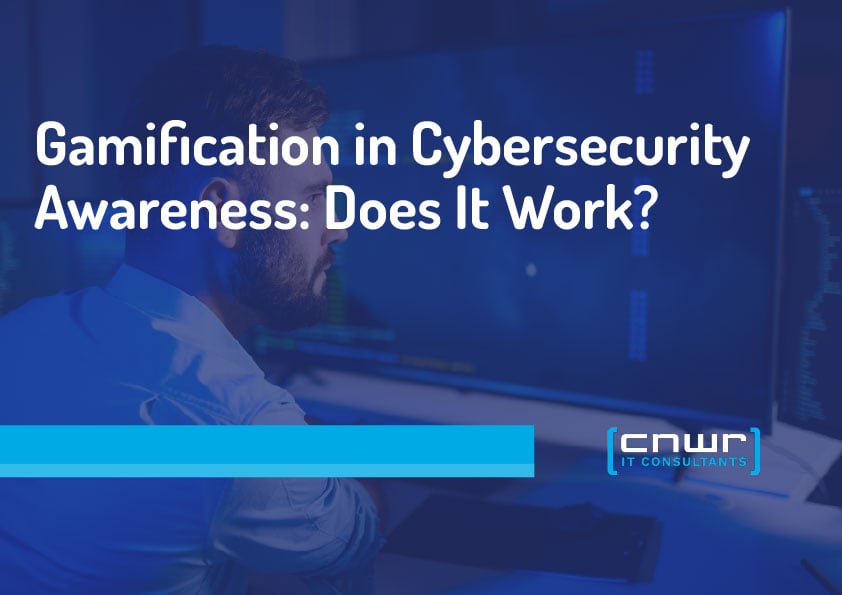In 2025, if you want people to pay attention, gamification is one of the sharpest tools on the table.
Traditional cybersecurity awareness training for employees still exists, but let’s be honest, most of it is forgotten within a week. The fatigue of this is real, especially for small businesses, manufacturing teams, and offices.
That’s where cybersecurity gamification comes in. It flips passive learning into active involvement.
Real scenarios. Real-time choices. Real consequences. When designed right, this approach taps into how people actually retain information. But the question is: does gamification actually work, or is it just another buzzword vendors are pushing?
Let’s find out.
Table of Contents:1. What Is Cybersecurity Gamification? 2. The Mechanics and Behavioral Science Behind Gamification 3. How Gamification in Cybersecurity Awareness Works 4. Importance of Cyber Security Awareness Training for Employees
5. Effective Cybersecurity Awareness Starts With Smart Design |
What Is Cybersecurity Gamification?
Cybersecurity gamification blends real-world cyber threats with game mechanics to improve how employees learn, react, and retain security knowledge. It's about simulating phishing attempts or ransomware scenarios in a safe, controlled environment.
Picture this: a warehouse team gets a mock email that mimics a supplier invoice scam. If someone clicks, the system flags it and explains why it was risky immediately. That moment sticks far better than a quarterly PowerPoint presentation.
The goal here is to cultivate smarter habits through real-time experience, not lectures. That’s the greatest way of shifting behavior in fields like IT.
|
Did you know? According to the Hoxhunt report, when phishing simulations mirror real-world scenarios and are paired with structured feedback, employee behavior improves rapidly, and the results last:
|
The Mechanics and Behavioral Science Behind Gamification
Gamified cybersecurity training isn’t about adding games to make boring content less boring. It’s about applying behavioral science to drive real change.
There’s a model for this called BJ Fogg’s Behavior Model, which is:
| Behavior = Motivation + Ability + Prompt |
This model helps shape habits, not just push information. It helps you create structured feedback, short challenges, and smart timing so that you can make all the difference.
There are two main approaches:
1. Structural gamification adds layers like points, streaks, and challenges around traditional material
2. Content gamification goes deeper, reshaping the material into something immersive: simulations, scenarios, and real-world decision-making
The “Super Mario Effect,” coined by Mark Rober, explains why this works. When users focus on progress, not failure, they stick with it longer and learn more. In practice, that means employees don’t dread training; they interact with it, make mistakes safely, and improve steadily.
| Pro Tip: Focus on positive reinforcement like rewards, streaks, and safe fails build habit loops more effectively than punishments. |
How Gamification in Cybersecurity Awareness Works
Cybersecurity gamification works by replacing passive learning with hands-on, scenario-based challenges that mimic real-world threats. It’s about making security habits automatic through practice.
Here’s how it plays out in a real-world setting:
Say, a small manufacturing firm rolls out a monthly “threat hunt” challenge-
-
Employees receive fake phishing emails based on real attack patterns in their industry
-
Each person who reports the email correctly earns a small reward or internal recognition
-
Those who miss the red flags get instant feedback explaining what they overlooked
-
Over time, reporting rates go up, risky clicks go down, and teams start spotting threats before IT even steps in
| Pro Tip: Tailor simulations to your industry’s top threats. |
Importance of Cyber Security Awareness Training for Employees
For teams that don’t sit behind computers all day, security threats often feel distant. That false sense of safety is exactly what attackers count on. When your employees go through awareness training, it fills the gap.
Here’s why it's essential:
1. Save yourself from costly mistakes
Most security breaches don’t start with alarms blaring. They start with someone clicking a link they thought was a supplier update. Cybersecurity training needs to focus on recognition, not just policy. Employees should be trained to identify subtle risks before they snowball into crises.
For example, a fake invoice disguised as a pharmaceutical order can slip through if the front desk isn't prepped. When awareness is high, mistakes get caught at the gate, before they turn into cleanup jobs.
2. IT teams can’t be everywhere
Smaller organizations often don’t have round-the-clock security teams. And even with managed cybersecurity services, internal vigilance is still necessary. Training fills that gap.
When your team knows how to spot threats and act early, it gives your IT partner more time to focus on the complex stuff. In a manufacturing facility, that could mean a machine operator understanding that a pop-up software update prompt isn’t just annoying, it could be malware.
3. Trust gets damaged faster than devices
Data loss is recoverable, but your reputation isn’t. Churches, unions, and community-focused organizations rely on trust. One breach involving donor information or internal communications can create ripple effects that last for years.
Employees trained in cybersecurity awareness don’t just protect data; they protect community relationships. That level of accountability starts with training that sticks, not check-the-box e-learning.
4. Cyber insurance won’t save you from every hit
More businesses are taking out cybersecurity insurance, but policies often require proof of preventative measures, including employee training. Without it, a claim could be denied.
And even if you’re covered, nobody wants to file a claim they could’ve avoided. The better move is investing in awareness training that teaches teams how to reduce risk exposure, keeping premiums low and incidents rarer.
5. Every role holds risk, not just IT or the admin
One of the most dangerous assumptions in small teams is that only the admin or tech team needs training. In reality, ransomware can come from any user, HR, sales, logistics, or even volunteers. Cybersecurity awareness needs to include everyone with access to a screen, no matter their job title.
Key Takeaways
-
Cybersecurity gamification turns routine training into behavior-focused, interactive learning that employees actually retain
-
Traditional cybersecurity awareness training for employees often fails to drive real action, but gamification changes that by making learning memorable
-
Even small organizations with limited IT staff benefit from gamified training that conditions better response habits across the team
-
The BJ Fogg Behavior Model and concepts like the “Super Mario Effect” explain why positive, prompt-driven reinforcement works better than fear-based training
-
Gamified platforms combine structure and story to create realistic scenarios that stick
Effective Cybersecurity Awareness Starts With Smart Design
Gamified security training is behavior science applied to a real-world problem. When employees engage, learn, and respond with confidence, your organization becomes harder to compromise. Especially for smaller teams without dedicated IT staff, building these habits early can prevent bigger problems down the road.
At CNWR, we help organizations like yours build cybersecurity programs that are practical, sustainable, and built for real people, not just IT pros.
Want to improve training without overwhelming your team?
Talk to a specialist to see how our cybersecurity services can work for your business.




.jpg)